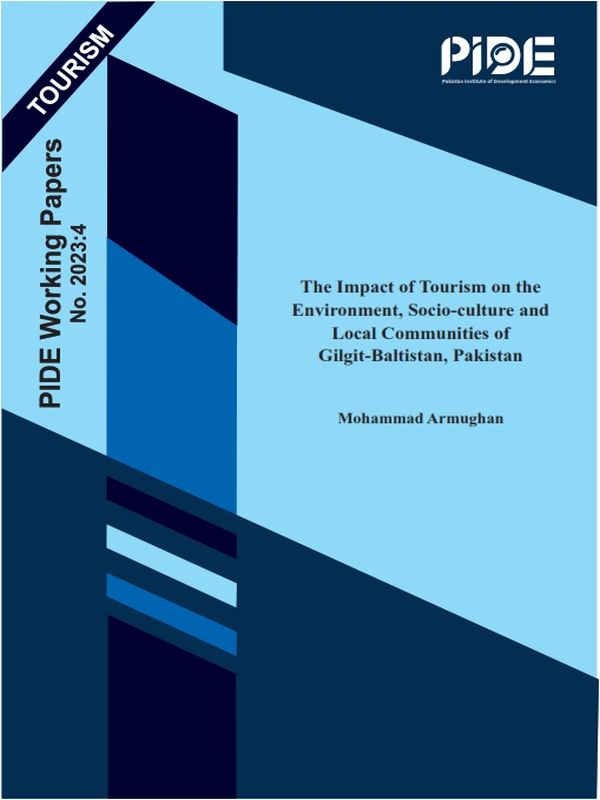
Pakistan Institute of Development Economics
- Home
Our Portals
MenuMenuMenuMenuMenuMenuMenu - ResearchMenuMenuMenuMenuMenuMenuMenu
- Discourse
- The PDR
- Our Researchers
- Academics
- Degree Verification
- Thesis Portal
- Our Portals
The Impact of Tourism on the Environment, Socio-culture and Local Communities of Gilgit-Baltistan, Pakistan
ABSTRACT
Gilgit-Baltistan (GB) lies in the northern part of Pakistan and has immense potential for tourism due to the immense beauty of its mountain peaks and many valleys and rivers. Many foreign and domestic tourists visit GB every year, with both positive and negative impacts on GB’s economy and its environment. However, the large influx of tourists affects the environment and local community. Thirty in-depth interviews were conducted to examine the perspective of the local community regarding tourism’s impact and the role of government in protecting the community. The results showed that tourism in GB generates employment opportunities for the locals but negatively impacts the environment by increasing solid waste, littering, air pollution, noise pollution, water contamination, deforestation, and traffic congestion.
Moreover, tourism has a considerable socio-cultural impact on the local community as the mode of dress, food, daily routine, beliefs, and values change over time. Lastly, Covid19 has affected GB in terms of economy and socio-culture. Therefore, there is a dire need for ecotourism in GB to mitigate environmental concerns and promote tourism.
1. INTRODUCTION
Tourism is considered a good source of employment, cultural promotion, revenue generation, and Gross Domestic Product (GDP) growth. Tourism has great potential for economic growth in developed and developing countries (Gumus et al., 2007). Tourism is acknowledged as a significant economic activity (Pham, 2012). It has positive and negative sides. Positively, it increases income per capita and living standards with employment and economic expansion (Hye & Khan, 2013). On the contrary, the cost of living for the local communities increases in due to crowds, traffic congestion, increasing crime rate, and environmental destruction by depleting natural resources (Nunkoo & Ramkissoon, 2010; Tohidy, 2011). Several studies have explored the local community perspective on tourism and the socio-cultural attitudes associated with tourism (Wall & Mathieson, 2006; Saqib et al., 2019; Jehan et al., 2022). Keeping in mind that every community has its values, traditions, and cultures, tourism impacts the local community in specific ways.
Tourism impacts are divided into three categories economic, environmental and social. The economic category comprises financial inflow from direct or indirect actions like creating business opportunities, job opportunities, revenue generation, tax collection from the hospitality industry and foreign exchange (Sinclair, 1998; Hye & Khan, 2013). The environment category includes environmental degradation of natural resources, biodiversity, and ecosystems (Nigar, 2018). The social category covers the variations in cultural, traditional, and dogmatic standards connected with the local community’s emotions (Fredline, 2002).
The ecological system plays a crucial role in tourism. Tourism plays a significant role in attaining Millennium Development Goals (MDGs), especially MDG 7, which is environmental sustainability (Lovric, 2011). For successful and sustainable tourism, local community perspectives and representations are crucial because every community has different attitudes towards tourism (Ahn et al., 2002).
Pakistan’s tourism industry is growing fast and has vast potential; it can be classified into four categories: historical, religious, ecotourism, and adventure (Arshad et al., 2018). Pakistan has spectacular tourist potential due to its rich history, diverse culture, mountain ranges, deserts, glaciers, and beautiful sceneries: in 2020, Pakistan’s tourism receipts were US $765 million (World Bank, 2022). According to the Travel and Tourist Development Index (TTDI), Pakistan is ranked 83 out of 140 countries in tourism (Uppink & Soshkin, 2022).
Gilgit-Baltistan is the capital of tourism in Pakistan. Its landscape covers lakes, valleys, mountains, and glaciers. The province is famous for its glorious sceneries and culture and is home to some of the highest peaks in the world, including K2 (8611m). the second-highest mountain in the world. Moreover, it is also renowned for its history, culture, landmarks, and the local community. Tourists predominantly visit GB for adventure sports such as climbing, hiking, camping, and paragliding.



